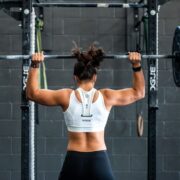
Revamp Your Fitness Routine with Bootcamp Workouts
Bootcamp workouts have become increasingly popular in recent years, offering a challenging and effective way to get fit. These workouts are typically high-intensity, full-body workouts that combine strength training, cardiovascular exercises, and interval training. The term “bootcamp” originated from military training camps, where recruits undergo intense physical training to build strength, endurance, and mental toughness.
Bootcamp workouts have evolved from their military roots and are now offered in various settings, including gyms, fitness studios, and even outdoor spaces. They are designed to push participants to their limits and provide a total body workout in a short amount of time. The workouts are typically led by a trainer or instructor who guides participants through a series of exercises that target different muscle groups and elevate heart rate.
The benefits of bootcamp workouts are numerous. Not only do they help burn calories and build strength, but they also improve cardiovascular health, boost metabolism, increase energy levels, and enhance mental toughness. These workouts are suitable for individuals of all fitness levels and can be modified to meet individual needs and goals.
Key Takeaways
- Bootcamp workouts are high-intensity training sessions that combine cardio and strength exercises.
- Incorporating bootcamp workouts into your fitness routine can improve your overall health and fitness level.
- When choosing a bootcamp workout, consider your fitness goals and level of experience.
- Essential equipment for bootcamp workouts includes resistance bands, dumbbells, and a mat.
- Sample bootcamp workout routines can be done at home or at the gym, and can help with weight loss and building strength and endurance.
Benefits of Bootcamp Workouts: Why You Should Incorporate Them into Your Fitness Routine
1. Burn more calories in less time: Bootcamp workouts are known for their high-intensity nature, which means you can burn a significant amount of calories in a short amount of time. The combination of strength training and cardiovascular exercises helps elevate heart rate and increase calorie burn both during and after the workout.
2. Build strength and endurance: Bootcamp workouts incorporate a variety of exercises that target different muscle groups, helping to build overall strength and endurance. The use of bodyweight exercises, resistance bands, dumbbells, kettlebells, and other equipment helps challenge muscles in new ways and promote muscle growth.
3. Improve cardiovascular health: The combination of cardiovascular exercises such as running, jumping jacks, and burpees, along with strength training exercises, helps improve cardiovascular health. These workouts increase heart rate and improve lung capacity, leading to better overall cardiovascular fitness.
4. Boost metabolism: Bootcamp workouts are known for their ability to boost metabolism. The high-intensity exercises and interval training help increase the body’s metabolic rate, allowing you to burn more calories throughout the day, even after the workout is over.
5. Increase energy levels: Regular participation in bootcamp workouts can lead to increased energy levels. The combination of physical activity, improved cardiovascular health, and increased strength and endurance can help combat fatigue and improve overall energy levels.
6. Enhance mental toughness: Bootcamp workouts are not only physically challenging but also mentally demanding. Pushing through difficult exercises and completing challenging workouts can help build mental toughness and resilience, which can translate into other areas of life.
How to Choose the Right Bootcamp Workout for Your Fitness Goals
When choosing a bootcamp workout, it’s important to consider your fitness goals, fitness level, and personal preferences. Here are some steps to help you choose the right bootcamp workout for your needs:
1. Identify your fitness goals: Determine what you want to achieve through your bootcamp workouts. Are you looking to lose weight, build strength, improve endurance, or a combination of these? Knowing your goals will help you choose a workout that aligns with your objectives.
2. Consider your fitness level: Bootcamp workouts can be intense, so it’s important to consider your current fitness level when choosing a workout. If you’re a beginner or have any health concerns, it may be best to start with a beginner-friendly bootcamp class or work with a personal trainer who can tailor the workout to your needs.
3. Research different types of bootcamp workouts: There are various types of bootcamp workouts available, each with its own focus and style. Some may be more cardio-focused, while others may emphasize strength training or a combination of both. Research different types of bootcamp workouts to find one that aligns with your goals and preferences.
4. Consult with a fitness professional: If you’re unsure about which bootcamp workout is right for you, it’s always a good idea to consult with a fitness professional. They can assess your fitness level, discuss your goals, and recommend the best workout for your needs.
Essential Equipment for Bootcamp Workouts: What You Need to Get Started
| Equipment | Description | Benefits |
|---|---|---|
| Dumbbells | Handheld weights | Builds strength, improves muscle tone, increases endurance |
| Resistance bands | Elastic bands used for resistance training | Improves flexibility, builds strength, targets specific muscle groups |
| Kettlebells | Weight with a handle used for swinging and lifting exercises | Improves cardiovascular health, builds strength, targets multiple muscle groups |
| Jump rope | A rope used for jumping exercises | Improves cardiovascular health, burns calories, improves coordination |
| Yoga mat | A mat used for yoga and other floor exercises | Provides cushioning, improves stability, prevents slipping |
One of the great things about bootcamp workouts is that they can be done with minimal equipment. Here are some essential items you’ll need to get started:
1. Comfortable workout clothes and shoes: Choose breathable, moisture-wicking clothing that allows for freedom of movement. Invest in a good pair of athletic shoes that provide support and stability.
2. Water bottle: Staying hydrated is crucial during intense workouts. Make sure to bring a water bottle to keep yourself hydrated throughout the session.
3. Towel: Bootcamp workouts can be sweaty, so having a towel on hand is essential to wipe away sweat and keep yourself comfortable.
4. Resistance bands: Resistance bands are versatile and can be used to add resistance to bodyweight exercises or for targeted strength training exercises.
5. Dumbbells: Dumbbells are great for adding resistance to exercises and building strength. Choose a weight that challenges you but allows you to maintain proper form.
6. Kettlebells: Kettlebells are another versatile piece of equipment that can be used for strength training exercises, as well as cardiovascular exercises like kettlebell swings.
7. Medicine ball: Medicine balls can be used for various exercises, including core work, upper body exercises, and explosive movements.
Bootcamp Workout Ideas: Sample Routines to Try at Home or at the Gym
1. Full-body circuit workout: This workout targets all major muscle groups and combines strength training exercises with cardiovascular exercises. Perform each exercise for a set amount of time or a certain number of repetitions before moving on to the next exercise. Repeat the circuit for multiple rounds.
– Push-ups
– Squats
– Mountain climbers
– Lunges
– Plank
– Burpees
2. HIIT (High-Intensity Interval Training) workout: HIIT workouts are known for their ability to burn calories and improve cardiovascular fitness. Alternate between periods of high-intensity exercise and short rest periods. Perform each exercise for a set amount of time or a certain number of repetitions before moving on to the next exercise.
– Jumping jacks
– High knees
– Jump squats
– Push-ups
– Bicycle crunches
– Plank jacks
3. Tabata workout: Tabata workouts are a form of high-intensity interval training that consists of 20 seconds of work followed by 10 seconds of rest, repeated for a total of 4 minutes per exercise. Choose 4 exercises and perform each one for 8 rounds.
– Burpees
– Mountain climbers
– Russian twists
– Jump lunges
4. Strength training workout: This workout focuses on building strength and muscle. Perform each exercise for a certain number of repetitions or sets.
– Squats (3 sets of 12 reps)
– Deadlifts (3 sets of 10 reps)
– Shoulder press (3 sets of 8 reps)
– Bent-over rows (3 sets of 10 reps)
– Bicep curls (3 sets of 12 reps)
– Tricep dips (3 sets of 10 reps)
5. Cardio-focused workout: This workout is designed to get your heart rate up and burn calories. Perform each exercise for a set amount of time or a certain number of repetitions.
– Jumping jacks (1 minute)
– High knees (1 minute)
– Jump rope (1 minute)
– Box jumps (1 minute)
– Running in place (1 minute)
– Mountain climbers (1 minute)
Tips for Staying Motivated During Bootcamp Workouts: How to Push Yourself to the Next Level
1. Set realistic goals: Set specific, measurable, achievable, relevant, and time-bound (SMART) goals for your bootcamp workouts. Having clear goals can help keep you motivated and focused on your progress.
2. Find a workout buddy: Working out with a friend or joining a bootcamp class can provide accountability and motivation. Having someone to push you and share the experience with can make the workouts more enjoyable.
3. Mix up your routine: Avoid getting bored by mixing up your bootcamp workouts. Try different exercises, formats, or classes to keep things interesting and challenging.
4. Track your progress: Keep a record of your workouts, including the exercises performed, sets, reps, and weights used. Tracking your progress can help you see how far you’ve come and provide motivation to keep pushing yourself.
5. Reward yourself: Set rewards for reaching milestones or achieving specific goals. Treat yourself to something you enjoy, such as a massage, new workout gear, or a healthy meal.
Common Mistakes to Avoid During Bootcamp Workouts: How to Prevent Injury and Maximize Results
1. Skipping warm-up and cool-down: Warm-up exercises are essential to prepare your body for the workout and prevent injury. Similarly, cool-down exercises help bring your heart rate down gradually and promote recovery.
2. Overtraining: It’s important to listen to your body and give it time to rest and recover between workouts. Overtraining can lead to burnout, decreased performance, and increased risk of injury.
3. Poor form: Proper form is crucial for maximizing results and preventing injury during bootcamp workouts. If you’re unsure about the correct form for an exercise, ask a trainer or instructor for guidance.
4. Not listening to your body: Pay attention to how your body feels during and after workouts. If something doesn’t feel right or you’re experiencing pain, it’s important to modify or stop the exercise and seek professional advice if needed.
5. Neglecting rest and recovery: Rest and recovery are just as important as the workouts themselves. Make sure to incorporate rest days into your routine and prioritize sleep, nutrition, and self-care to support your body’s recovery process.
Bootcamp Workouts for Weight Loss: How to Shed Pounds and Build Muscle with High-Intensity Training
Bootcamp workouts can be an effective tool for weight loss when combined with a healthy diet and lifestyle. Here are some tips for using bootcamp workouts to shed pounds and build muscle:
1. Importance of nutrition: To lose weight, it’s important to create a calorie deficit by consuming fewer calories than you burn. Focus on eating a balanced diet that includes lean proteins, whole grains, fruits, vegetables, and healthy fats.
2. Incorporating strength training: Strength training is essential for building muscle and increasing metabolism. Include exercises that target all major muscle groups in your bootcamp workouts to maximize calorie burn and muscle growth.
3. HIIT workouts for weight loss: High-intensity interval training (HIIT) workouts are particularly effective for weight loss as they help burn calories both during and after the workout. Incorporate HIIT exercises into your bootcamp workouts to increase calorie burn and improve cardiovascular fitness.
4. Tracking progress: Keep track of your weight loss progress by regularly weighing yourself, taking measurements, or using other methods such as body fat percentage measurements or progress photos. Seeing progress can help keep you motivated and on track with your weight loss goals.
Bootcamp Workouts for Strength and Endurance: How to Build a Stronger, More Resilient Body
Bootcamp workouts can help build strength and endurance by incorporating a variety of exercises that challenge different muscle groups and elevate heart rate. Here are some tips for using bootcamp workouts to build a stronger, more resilient body:
1. Incorporating resistance training: Resistance training is key for building strength and muscle. Include exercises that target all major muscle groups, such as squats, deadlifts, push-ups, rows, and lunges, in your bootcamp workouts.
2. Progressive overload: To continue building strength and endurance, it’s important to progressively increase the intensity or difficulty of your workouts over time. This can be done by increasing the weight, reps, sets, or difficulty of exercises.
3. Plyometric exercises: Plyometric exercises, also known as explosive exercises, are great for building power and improving athletic performance. Include exercises such as box jumps, burpees, jump squats, and plyometric push-ups in your bootcamp workouts.
4. Endurance-focused workouts: To improve endurance, incorporate cardiovascular exercises such as running, cycling, rowing, or jumping rope into your bootcamp workouts. Aim to gradually increase the duration or intensity of these exercises over time.
Why Bootcamp Workouts Are the Perfect Way to Revamp Your Fitness Routine
Bootcamp workouts offer a challenging and effective way to get fit and achieve your fitness goals. Whether you’re looking to burn calories, build strength and endurance, lose weight, or improve overall fitness, bootcamp workouts can provide the intensity and variety needed to see results.
By incorporating bootcamp workouts into your fitness routine, you can burn more calories in less time, build strength and endurance, improve cardiovascular health, boost metabolism, increase energy levels, and enhance mental toughness. These workouts are suitable for individuals of all fitness levels and can be modified to meet individual needs and goals.
Before starting a new workout routine, it’s always a good idea to consult with a fitness professional who can assess your fitness level, discuss your goals, and recommend the best bootcamp workout for your needs. So why not give bootcamp workouts a try and revamp your fitness routine today? Your body will thank you.
FAQs
What are bootcamp-style fitness programs?
Bootcamp-style fitness programs are high-intensity workouts that combine strength training, cardio, and endurance exercises. These programs are designed to challenge participants both physically and mentally, often incorporating military-style drills and exercises.
What are the benefits of participating in a bootcamp-style fitness program?
Participating in a bootcamp-style fitness program can lead to improved cardiovascular health, increased strength and endurance, weight loss, and improved overall fitness. These programs also provide a sense of community and accountability, as participants often work out in groups and are encouraged to support and motivate each other.
Who can participate in a bootcamp-style fitness program?
Bootcamp-style fitness programs are typically open to individuals of all fitness levels, although some programs may be more intense than others. It is important to consult with a doctor before starting any new exercise program, especially if you have any pre-existing medical conditions or injuries.
What should I expect during a bootcamp-style fitness class?
During a bootcamp-style fitness class, you can expect to participate in a variety of exercises, including bodyweight exercises, cardio drills, and strength training exercises using weights or resistance bands. Classes may also include partner or team exercises, obstacle courses, and other challenges designed to push participants to their limits.
What should I wear to a bootcamp-style fitness class?
It is important to wear comfortable, breathable clothing that allows for a full range of motion. Athletic shoes with good support and traction are also recommended. Some classes may require specific equipment, such as gloves or a yoga mat, so be sure to check with the instructor or gym beforehand.
How often should I participate in a bootcamp-style fitness program?
The frequency of participation in a bootcamp-style fitness program will depend on your fitness goals and schedule. Some participants may choose to attend classes several times a week, while others may only attend once or twice a week. It is important to listen to your body and avoid overtraining, as this can lead to injury or burnout.


















